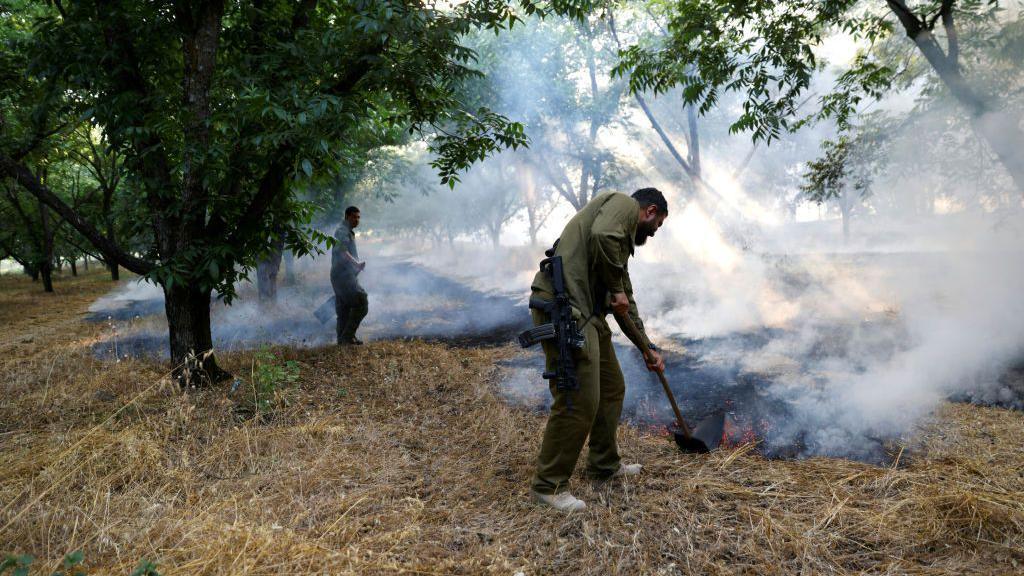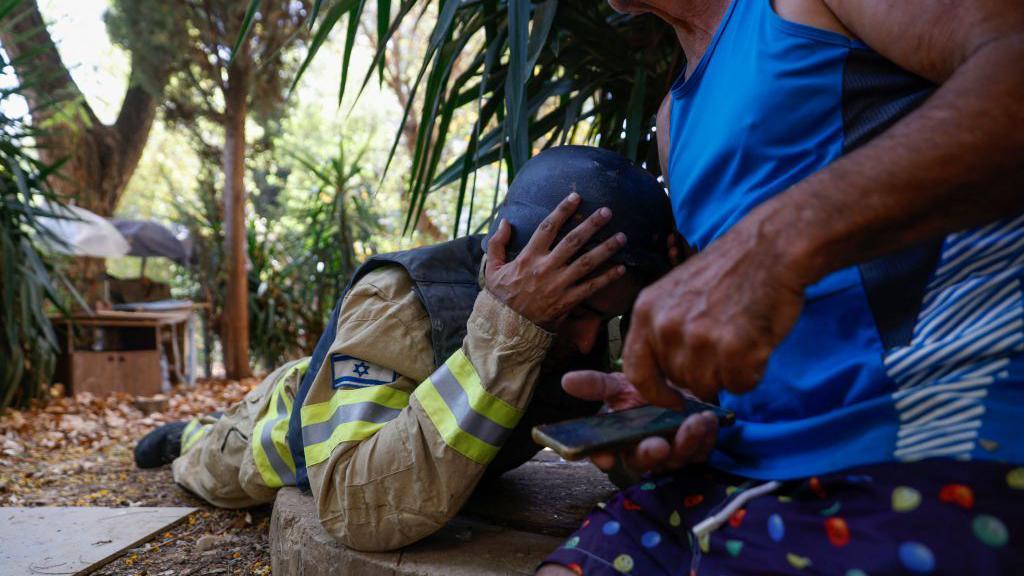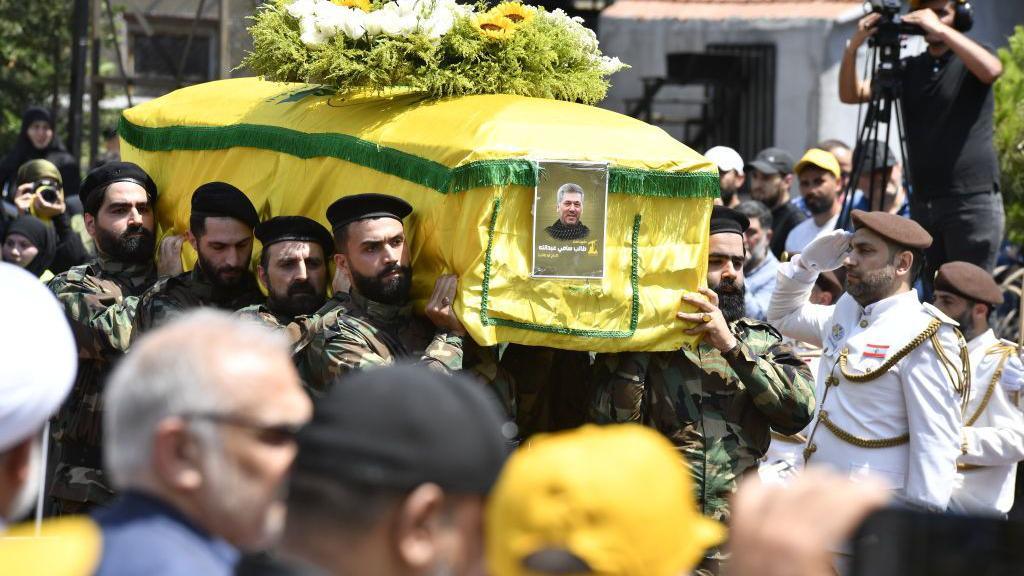Israel and Hezbollah play with fire as fears grow of another war

Israelis have been tackling fires in the north triggered by Hezbollah rockets in recent weeks
- Published
It’s a peculiar political twist that hostilities rose between Israel and Hezbollah this week, even as the missiles ebbed.
The recent intense exchange of fire replaced, during the Muslim holiday of Eid al-Adha, with a fiery volley of threats, the familiar drum beat of deterrence spotlighting the path to war.
The Hezbollah leader, Hassan Nasrallah, on Wednesday threatened to invade northern Israel if a full-scale war with Israel broke out.
He also said Hezbollah had “new weapons” which would be seen in the field.
But, he added, the group did not want full-scale war with Israel - and viewed its involvement as support for its Hamas ally in Gaza.
On Tuesday, Hezbollah released drone footage of the northern Israel city of Haifa, with key military and civilian sites marked on the video. It was widely seen as a veiled threat to Israel not to escalate the conflict – a lethal strike on Haifa would likely trigger all-out war.
Mr Nasrallah said it was part of Hezbollah’s “psychological warfare” against its enemy.
Hours after the video was published, Israel’s Foreign Minister, Israel Katz, said the country was “very close to the moment of decision to change the rules against Hezbollah and Lebanon”.
In an all-out war, he said, “Hezbollah will be destroyed and Lebanon will be severely hit”.
Israel’s military said that operational plans for an offensive in Lebanon had been “approved and validated”.
There is a widely held view that neither Israel nor Hezbollah want to trigger a war right now. That war – between two well-armed enemies – would risk devastation to millions of people on both sides of the border, and also risk dragging in Hezbollah’s backer, Iran, and the US, Israel’s key ally.
But the line between deterrence and desire for war is getting harder to see.

Israelis duck for cover as sirens warn of rockets launched over the border from southern Lebanon
Some in Israel’s government believe that the Hamas attacks on 7 October changed calculations of security, and that residents of northern areas won’t be able to return to their homes unless Hezbollah is defeated on the battlefield.
Many residents in the north agree.
More than 60,000 of them have been living in temporary accommodation away from the border since Hezbollah began launching rockets and missiles into northern Israel in support of its Palestinian ally, Hamas.
More than 90,000 Lebanese have also been displaced as Israeli forces have responded with air and artillery strikes.
A poll of 800 Israelis this week by the Jewish People Policy Institute found that more than 60% wanted to attack Hezbollah “with full force”.
More than a third (36%) said they wanted to do it “as soon as possible” – even before Israel had finished fighting Hamas in Gaza. That figure has grown since a similar poll three months ago.
Hezbollah fires dozens of rockets into Israel after strike kills commander
- Published12 June 2024
Israelis using gardening tools to fight wildfires sparked by Hezbollah rockets
- Published5 June 2024
Lebanon fears intensification of Israel's Hezbollah offensive
- Published13 May 2024
The war in Gaza is another reason why Israel’s government might be nervous of opening up a second, much tougher war with Hezbollah at the same time.
But this month it raised the cap on the number of reservists it could call on, from 300,000 to 350,000, fuelling speculation that a war in the north had not been ruled out.
The government is also trying to prolong a temporary extension of reserve duty, adding a year onto the age limit at which troops can be called on to serve.
And targets on both sides have continued to widen over the past eight months, as cross-border strikes have intensified.
The days leading up to Eid saw a furious volley of drones and rockets from Lebanon, after Israel killed a senior Hezbollah commander, Taleb Abdallah.
That followed a month of spiralling attacks by Hezbollah, with an increase in anti-tank missiles and drones sent across the border.
The growing tit-for-tat conflict risks tripping the two sides into war, if a target is seen as too sensitive, or the casualties too high.
So far, the UN says more than 400 people have been killed in Lebanon, including many civilians.
At least 25 people – soldiers and civilians – have been killed in Israel.

Hezbollah fired hundreds of projectiles into northern Israel after its senior commander, Taleb Abdallah, was killed in a strike on 11 June
The US sent its envoy to both sides of the border this week to try to resolve the conflict, but Hezbollah has been clear that it is acting in solidarity with its Hamas ally, and a ceasefire deal in Gaza is widely seen as the only viable path to a diplomatic solution in the north.
For Israel’s embattled Prime Minister Benjamin Netanyahu, under pressure to restore calm, there are benefits to continuing both conflicts.
It would be hard for him to claim victory in Gaza without killing, capturing or expelling the Hamas leadership, and while the group still has organised battalions intact.
And each week that the war against Hamas continues, his forces target more Hezbollah commanders, and more Hezbollah positions along the northern frontier – which may help him make the case for residents to return, when both conflicts do end.
Playing for time is Mr Netanyahu’s speciality.
In the north, both sides are playing with fire.